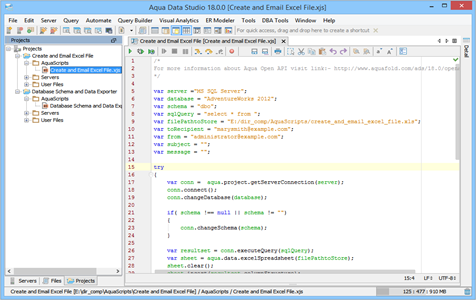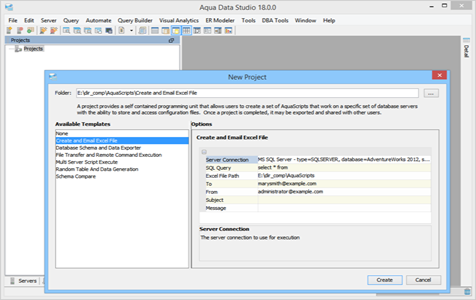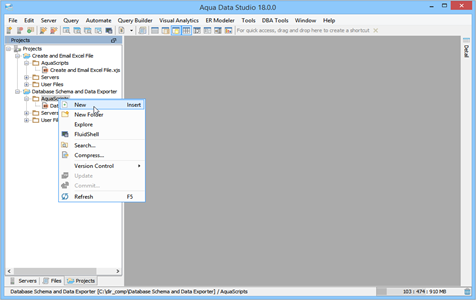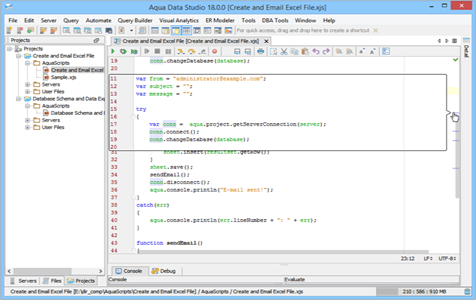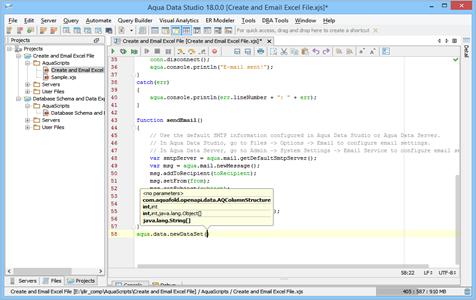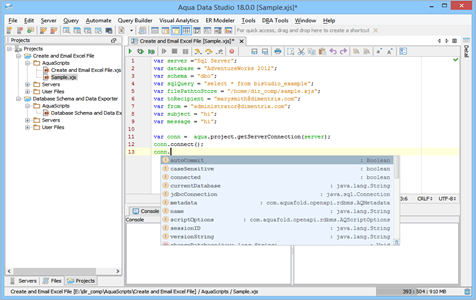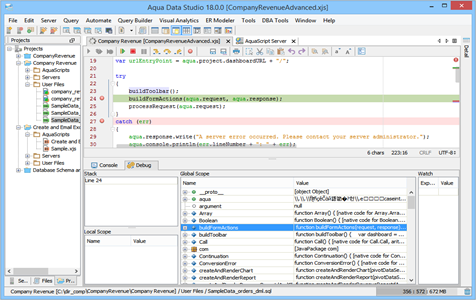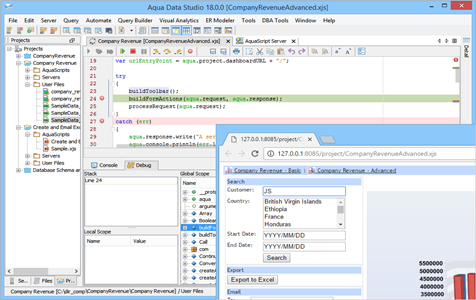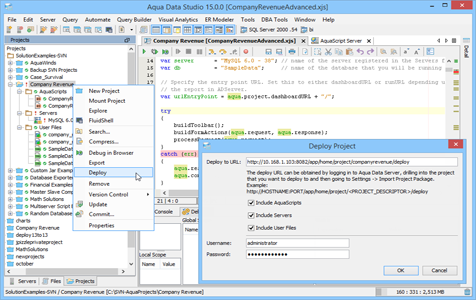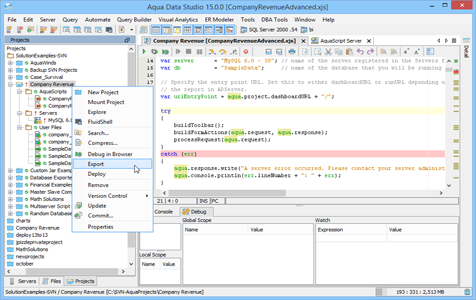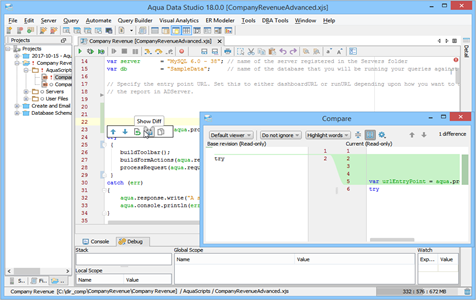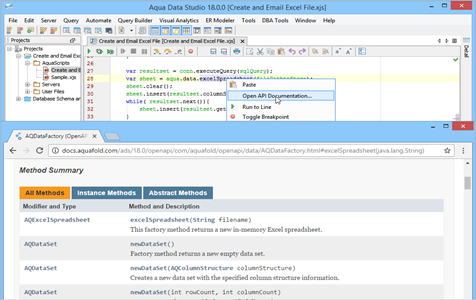JavaScript IDE & Open APIs
Aqua Data Studio offers a full-fledged Integrated Development Environment (IDE) with a set of programming interfaces called Aqua Open APIs that access built-in functionalities such as database access, schema DDL generation, grid and pivot charts, compare tools, version control and much more. Developers can invoke Aqua Open APIs via AquaScript — a simple JavaScript based programming language supported in Aqua Data Studio. The IDE also provides tools for executing and debugging AquaScripts. AquaScripts have full access to the Java APIs and any proprietary Java libraries that you include in the Aqua Data Studio classpath.
AquaScript Templates greatly simplify the task of writing AquaScripts by offering templates for your most common scripting needs. Six in-built templates are included: creating and emailing Excel files, exporting schema objects and data, transferring files to/from remote systems, executing multi-server scripts, random table and data generation, and comparing schemas.
Aqua Data Studio scripting IDE includes the following functions:
Create AquaProjects to organize tasks
The Aqua Data Studio Tree Panel contains the Project Browser. Within the Projects Browser, right click and select New Project to create an AquaProject. Every project has an AquaScripts directory, a Servers directory and a User Files directory. You can register a database server and create, debug and execute a set of AquaScripts that work on it. AquaProjects allow you to organize your software development tasks into self contained programming units. Once a project is completed you can export or share with your team.
Use AquaScript Templates to automatically generate code for your most common scripting needs. These templates provide an easy to use interface to input values and create ready-to-execute scripts. Upon choosing a template, an AquaScript is generated & stored in the AquaScripts folder with the .xjs extension. Edit the AquaScript for further modification and execution
Create AquaScripts to automate tasks
Use Open APIs to write AquaScripts and build fully automated end-to-end solutions based on your business requirements. To create a new AquaScript select the AquaScripts folder from your AquaProject and use the Insert key to create a new AquaScript. AquaScripts are identified by their .xjs file extension. All of the Open APIs are available through the global variable named “aqua”, which is an instance of the “AQAqua” class. AquaScripts may also access any other proprietary or Open Source Java libraries included in the Java Virtual Machine (JVM) classpath. AquaScripts are executed within Aqua Data Studio using the Mozilla Rhino1 engine.
AquaScript Editor
The fully functional editor for AquaScripts provides autocompletion, syntax coloring, bookmarks, abbreviations, find/replace, incremental search and more.
Execute AquaScripts
Execute AquaScripts with Ctrl+E. Invoke the debugger using Ctrl+Alt+Enter. The debugger allows you to step through, pause and set breakpoints in the code. The debugger highlights the breakpoints and indicates which breakpoint paused the execution. This makes it easy to evaluate variables and conditional flow of code.
Debug in Browser
The AquaScript Editor debugs an AquaScript in a browser with Aqua Data Studio’s embedded web server. Form input and page interaction within this browser can dynamically interact with your AquaScripts.
Export AquaProject
AquaProjects can be exported to disk as zip files.
Version Control Integration
Aqua Data Studio provides integration of AquaProjects with several Version Control Systems like CVS, Subversion (SVN), Git and Perforce. AquaScripts associated with a version control repository can be edited and saved in the AquaScripts Editor.
Context-sensitive Help
The editor provides context-sensitive help as you write your scripts. Simply press Shift-F1 and the API documentation of the object you are currently working on (or have selected) will open in your web browser.
List of Aqua Data Studio/Server Open APIs
- com.aquafold.openapi.archive – A set of methods and algorithms to archive files
- com.aquafold.openapi.chart – A set of methods for rendering charts
- com.aquafold.openapi.compare – A set of methods for comparing files, directories and schemas
- com.aquafold.openapi.crypto – A set of cryptographic functions
- com.aquafold.openapi.data – A set of functions for working with data grids and pivot tables
- com.aquafold.openapi.filesystem – A set of functions for accessing and managing computer file systems
- com.aquafold.openapi.form – A set of methods for implementing HTML forms
- com.aquafold.openapi.io – A set of methods for reading and writing in TXT, HTML and Excel formats
- com.aquafold.openapi.mail – A set of methods for sending and receiving e-mails
- com.aquafold.openapi.math – A set of mathematical and statistical functions
- com.aquafold.openapi.net – A set of networking methods
- com.aquafold.openapi.project – A set of methods which abstract the resources in the Aqua Project so that they may be accessed programmatically and identically in Aqua Data Studio
- com.aquafold.openapi.random – A set of random data generators
- com.aquafold.openapi.rdbms – A set of methods for accessing various types of databases
- com.aquafold.openapi.rdbms.schema – A set of methods for manipulating database objects
- com.aquafold.openapi.rdbms.util – A set of methods for parsing and formatting SQL statements
- com.aquafold.openapi.report – A set of methods for database querying and reporting
- com.aquafold.openapi.type – A set of methods for data manipulation and validation for various data types
- com.aquafold.openapi.util – A set of convenient methods for development and debugging
- com.aquafold.openapi.vcs – A set of methods for working with Git, Perforce, CVS and Subversion version management systems
References
- ^ Rhino (JavaScript engine) Wikipedia article. Rhino is an open source JavaScript engine.
- ^ JavaScript Wikipedia article. JavaScript is a prototype-based scripting language that is dynamic, weakly typed and has first-class functions.
- ^ DDL (Data Definition Language) Wikipedia article. A data definition language or data description language (DDL) is a syntax similar to a computer programming language for defining data structures, especially database schemas.
